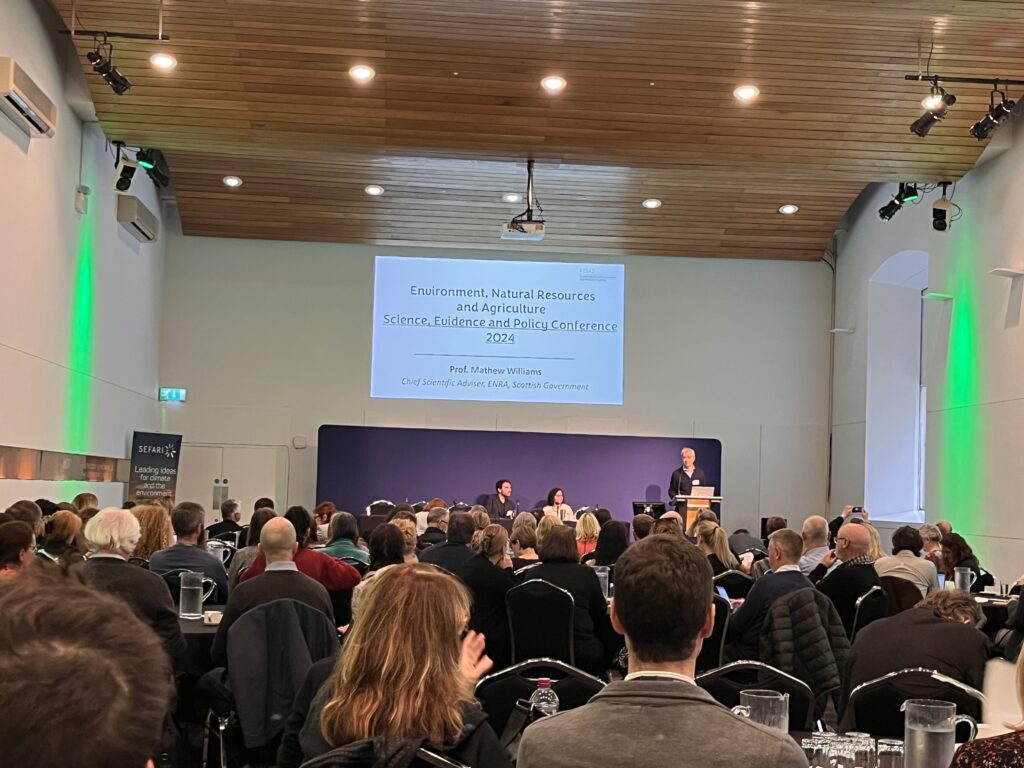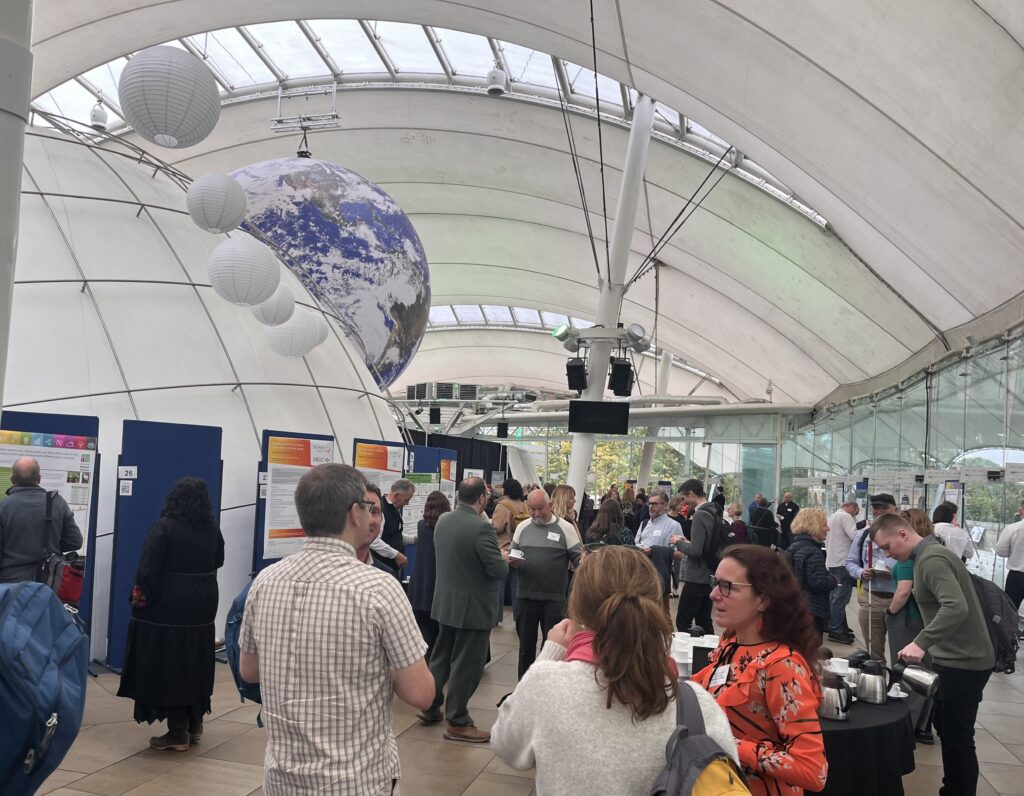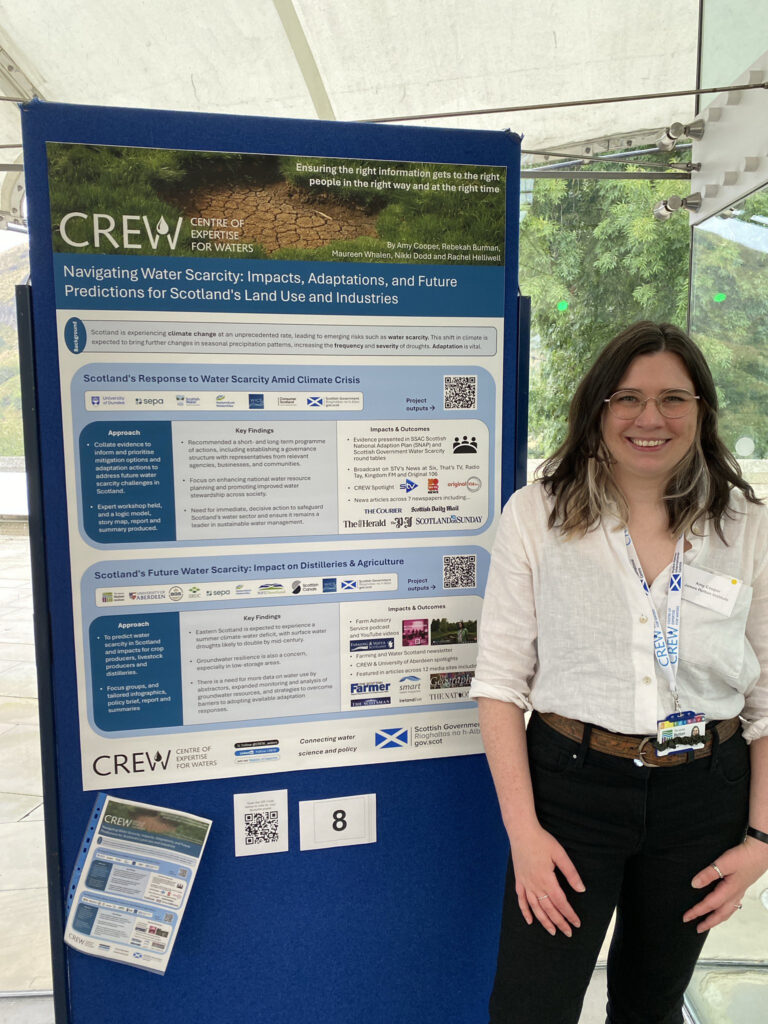James Hutton Institute at the ENRA Science Policy Conference at ODE
By Lorna Dawson, Head of Forensic Science
A great day was had by all on Monday the 23rd September 2024 at Our Dynamic Earth, Edinburgh. At the Environment, Natural Resources and Agriculture Research Portfolio ENRA Science Policy Conference, scientists mingled with policy makers and representatives from across the Agencies.
Rural and Environmental Science and Analytical Services (RESAS), Scottish Government (SG) hosted the one-day in-person conference bringing together stakeholders from across the rural and environmental research and policy landscape in Scotland. Representatives were from all the SEFARI Gateway institutes (James Hutton Institute, SRUC, Rowett, Moredun, RBGE and BioSS), and also from the Centres of Expertise (CREW, CXC, PHC, SEFARI Gateway). SEFARI Gateway was instrumental in planning and hosting the event and the outputs from the day will be posted later on the SEFARI Gateway web site.
The event provided an opportunity to researchers, including early career researchers, across the ENRA Portfolio, to display their research and highlight recent research outputs and impact. The networking event provided a forum for researchers and policy makers from across the public sector to discuss key cross cutting strategic issues affecting Scotland’s environment, communities, and rural economy. The event enabled policy colleagues to discuss with the research community policy priorities and potential future evidence needs, in particular key issues for the next 5-year strategic programme of research. This year the conference focussed on the topic of Climate Change Adaptation. Keynote speeches were delivered from both a policy and science perspective, highlighting opportunities and challenges of moving adaptation forward to ensure a resilient and just future for our rural communities in Scotland. Impact case studies were presented, highlighting successful science policy interactions. Interactive round table discussions to supported networking and fostered connections between scientists and policy makers. Panel discussions and breakout sessions were held on how we can accelerate the adoption of transformative adaptation for long term resilience.
ENRA Science Policy Conference poster presentations
Posters were presented throughout the day to display the range of outputs from across environment, natural resources, and agricultural research in Scotland. This article features six of the impact stories presented at the poster session, all involving work by scientists from the James Hutton Institute. I was able to chat with six of the presenters to gain a bit more of the flavour of the incredible depth and breadth of work being carried out as part of the ENRA portfolio of research. Delivering research with real policy and industry impact.


A packed auditorium to hear the keynote presenters and the interactive panel discussions at the conference and poster session.
Hemp in Scotland
The first story was delivered by Madalina Neacsu of the Rowett Institute, University of Aberdeen, on ‘Growing hemp on Scotland: Exploring its impact on soil health,’ a collaborative piece of work with James Hutton Institute including effects on soil health.
Due to its environmental credentials, hemp could realistically be a new food crop in Scotland. From 2021, eleven different farms were growing agricultural hemp for seed in Northeast Scotland for the first time and in 2022 the first Scottish commercial hemp oil was produced. At three of these farms, a pilot study started in 2023 to assesses the impact of growing hemp on soil quality. Soil samples were collected in Spring and Autumn 2023, after one season of growing hemp in Spring 2024, again after one season of growing hemp (2023) compared with growing a cereal crop in the same year and on the same farms. The preliminary data showed that the soil organic matter values (loss on Ignition at 450 ºC and 900 ºC) were significantly higher from spring to autumn 2023 and also in the year-following 2024 after hemp cultivation (compared with cereals). These findings support the potential suitability of hemp to be included as a rotation crop in Scotland.
Madalina Neacsu from the Rowett, University of Aberdeen answered a few questions I asked her while we were at the event.
Understanding Potato Cyst Nematodes to preserve Scottish potato-growing
The next story I heard was from James Price of the James Hutton Institute, on ‘Understanding Potato Cyst Nematode decline rates to preserve Scottish potato-growing land’.
Potato cyst nematodes (PCN) are currently the biggest pathogenic threat to the Scottish potato sector, with predictions suggesting that PCN could collapse the Scottish seed industry by 2050. Knowledge of how PCN populations decline in the absence of a host is vital to support agronomic practices and management strategies. However, little information is available for population decline under Scottish conditions and how this might be affected by climate change. In addition to supporting novel zero-waste-focussed management techniques, this project is also assisting larger grower-directed initiatives such as the Plant Health Centre’s PCN Action Scotland project.
James Price of the James Hutton Institute answered some questions about his work with PCN.
Turning the tide on potato viruses using data science and machine learning
Peter Skelsey, also of the James Hutton Institute, presented a poser on the topic of ‘Turning the tide on potato viruses using data science & machine learning.’
Scotland has a global reputation for producing high-quality seed potatoes, but recent years have seen a dramatic increase in the incidence of potato viruses. This is partially due to changing climatic conditions, with warmer winters leading to increased survival of overwintering aphid vectors, and to the loss of key aphicides used for their control. Data science at the James Hutton Institute is providing an unprecedented overview of the evolving virus situation in Scotland, and new tools to help guide data-driven decision-making for improved virus management are being developed. The relevance of this work to industry is evidenced by the funds which have been won to develop new national warning systems for potato viruses.
Machine learning and how it can assist in our treatment of photo viruses was the topic of Peter Skelsey’s work from the James Hutton Institute, and he answered a few questions on the topic.
Careers and skills for a future climate
Q1. What are you doing to promote youth to consider careers and develop skills in the future?
Q2. Please give example of how you are giving young people a voice?
Q3. What’s your main role in this collaborative project?
Maxine Scott of Skills Development Scotland is working with Ali Karley of the James Hutton Institute and others, and I met Maxine to chat about the work they are doing developing skills appropriate for a changing climate.
The urgent need for climate-resilient communities and economy poses fundamental questions about the role and mission of both research and education. The poster “Careers and skills for a future climate” displayed a novel multi-actor and multi-generational model for knowledge exchange, which aims to give young people – the future workforce – agency in co-designing, with research and industry, the pathways to climate resilience and to help find the necessary skills and jobs underpinning this transition. This model was demonstrated in a one-day workshop with the support of SEFARI funds and the participation of 69 S5/S6 students from 11 schools in Perth & Kinross, Dundee and Edinburgh. This collaborative approach is a novel way to engage with different stakeholders and address their needs, and hence build a new path to restore a “broken science-society contract” in a time of polarisation and backlash against climate transition.
Maxine Scott, from Skills Development Scotland, working with Ali Karley and team from James Hutton Institute, answered a few questions about the work they have been carrying out using a collaborative approach, presenting results from a workshop held with senior school pupils in Scotland (funded by SEFARI Gateway).
Ensuring future resilience to pest and disease threats – a multi-disciplinary approach
Ali Karley of the James Hutton Institute also presented on her poster ‘Ensuring future resilience to pest and disease threats – a multi-disciplinary approach.’
The sustainability of agricultural production in Scotland and globally is under pressure from environmental stresses (climate change, soil degradation, pest, and diseases) and influenced also by economic and political factors. Scenario planning research with agricultural stakeholders in farming, agronomy, regulation, research, and policy has explored future possibilities about potential effects of pests and diseases. Four plausible scenarios were co-developed based on varying hypotheses of global and national climate, economy, and political drivers in a 10-year horizon and how these could affect the sector. The scenarios were assessed for the likely impacts of three pests and diseases found from predictive modelling as increasing threats to crop production. The research provided recommendations for adapting the sector and mitigating against future pest and disease threats. To extend this co-design approach into agricultural practice, Hutton scientists are collaborating with stakeholders to develop methods for combatting new insect pest problems resulting from a changing climate.
Ali Karley from the James Hutton Institute, spoke with me about the work she has been carrying out using scenario planning to help ensure resilience of crops in Scotland to crops and diseases.
Novel tests to detect coliphages in drinking water
Clara Benavent Celma of the James Hutton Institute, presented her work on ‘Novel tests to detect coliphages in drinking water.’
Bacteriophages (phages) are viruses that infect bacteria and are the most widely distributed and abundant biological form on Earth. Bacteriophages that infect coliform bacteria are known as coliphages, and their survival and incidence in aquatic environments resemble those of human viruses more closely than most current commonly used bacterial indicators. Therefore, they have been proposed as good water quality indicators. In January 2021, the recast Drinking Water Directive 98/83/EC established somatic coliphages as a new indicator required for operational monitoring of the drinking water treatment process. Culture-based detection and enumeration of coliphages takes an average of 18 to 24 hours to yield results. In this work, we successfully developed a novel molecular method to detect somatic coliphages in drinking water faster than using standard methods and that detects somatic coliphages by family. The phase-by-phase process of the novel molecular method development was described very clearly in the poster.
Clare Buenaventura Celma poster.
Clare Buenaventura Celma, James Hutton Institute, described what bacteriophages are and how a novel molecular method can help improve the speed of detection in drinking water.
Maddy Giles also from James Hutton Institute presented a poster on ‘Can plant – soil interactions be a controller on GHG emissions from soils?’ This showed how plant-soil interactions play an important role in regulating nutrient cycling in soils, with their management representing a potential means to regulate CO2 and N2O emissions and the sequestration of C as soil organic matter (SOM). Consequently, targeting beneficial plant-soil interactions is likely to be an important tool for sustainable agriculture and the maintenance of soil health as well as achieving net zero emissions targets and creating climate resilient systems particularly in grasslands. The poster showed how there is potential to mitigate the production of CO2 through the selection of grasses that promote the immobilization of C rather than its emission as CO2 and also that these differences are linked to the soil microbiome.
Amy Cooper, CREW and JHI presented a poster on her work on ‘Navigating Water Scarcity: Impacts, Adaptations, and Future Predictions for Scotland’s Land Use and Industries.’ Water scarcity, worsened by climate change, critically affects almost every sector and region. The relationship between water scarcity and land use is significant, directly impacting water availability and resilience. This poster explored the theme of water scarcity by showcasing a cluster of recent science-policy CREW projects; understanding the relationship between water scarcity and land use in private water supply catchments – a review, climate crisis: informing Scotland’s actionable mitigation and adaptation response to water scarcity, future predictions of water scarcity in Scotland: impact on distilleries and agricultural abstractors.
Until next year
Well done to all the poster presenters, from all organisations, and in particular to the prize winners, which were presented with awards at the end of the day. Poster prizes were awarded to Madalina Neacsu, Rowett Institute, Peter Skelsey, James Hutton Institute, and Matt Elliot, RBGE. Matt’s poster was on how RBGE are improving how businesses moving plants (known as professional operators) prove that they have the necessary knowledge of the notifiable pests that could affect the plants that they grow, manage or handle. RBGE have produced a prototype webtool that can be used to understand the pest risks associated with the 39 top GB plant pests.
Many congratulations also to Amy Cooper who was awarded the Early Career Researcher prize. This winning entry showcased research on water scarcity undertaken through a collaborative effort from the University of Dundee, JHI, the University of Aberdeen, and SG water delivery partners.

Thanks to everyone for taking part and making it a great day: we all look forward to seeing you again next year to hear more of the examples of scientific research having a real impact on Scottish policy and improving our lives.
You can read more from Lorna on the SEFARI site, read her blog on the estate at Glensaugh here.
Disclaimer: The views expressed in this blog post are the views of the author, and not an official position of the institute or funder.
